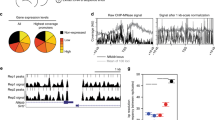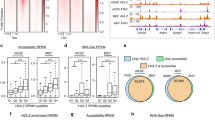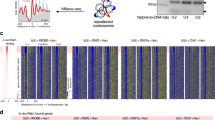Abstract
Transcriptional activation is often associated with chromatin remodeling. However, little is known about the dynamics of remodeling of nucleosome arrays in vivo. Upon induction of Saccharomyces cerevisiae PHO5, a novel kinetic assay of DNA methyltransferase accessibility showed that nucleosomes adjacent to the histone-free upstream activating sequence (UASp1) are disrupted earlier and at higher frequency in the cell population than are those more distal. Individually cloned molecules, each representing the chromatin state of a full promoter from a single cell, revealed multiple promoter classes with either no remodeling or variable numbers of disrupted nucleosomes. Individual promoters in the remodeled fraction were highly enriched for contiguous blocks of disrupted nucleosomes, the majority of which overlapped the UAS region. These results support a probabilistic model in which chromatin remodeling at PHO5 spreads from sites of transactivator association with DNA and attenuates with distance.
This is a preview of subscription content, access via your institution
Access options
Subscribe to this journal
Receive 12 print issues and online access
$189.00 per year
only $15.75 per issue
Buy this article
- Purchase on Springer Link
- Instant access to full article PDF
Prices may be subject to local taxes which are calculated during checkout






Similar content being viewed by others
References
Owen-Hughes, T. & Workman, J.L. Experimental analysis of chromatin function in transcription control. Crit. Rev. Eukaryot. Gene Expr. 4, 403–441 (1994).
Lemon, B. & Tjian, R. Orchestrated response: a symphony of transcription factors for gene control. Genes Dev. 14, 2551–2569 (2000).
Fry, C.J. & Peterson, C.L. Chromatin remodeling enzymes: who's on first? Curr. Biol. 11, R185–R197 (2001).
Narlikar, G.J., Fan, H.Y. & Kingston, R.E. Cooperation between complexes that regulate chromatin structure and transcription. Cell 108, 475–487 (2002).
Kuo, M., Zhou, J., Jambeck, P., Churchill, M.E.A. & Allis, C.D. Histone acetyltransferase activity of yeast Gcn5p is required for the activation of target genes in vivo. Genes Dev. 12, 627–639 (1998).
Agalioti, T. et al. Ordered recruitment of chromatin modifying and general transcription factors to the IFN-β promoter. Cell 103, 667–678 (2000).
Lomvardas, S. & Thanos, D. Modifying gene expression programs by altering core promoter chromatin architecture. Cell 110, 261–271 (2002).
Vogel, K., Hörz, W. & Hinnen, A. The two positively acting regulatory proteins PHO2 and PHO4 physically interact with PHO5 upstream activation regions. Mol. Cell. Biol. 9, 2050–2057 (1989).
Kaffman, A., Herskowitz, I., Tjian, R. & O'Shea, E.K. Phosphorylation of the transcription factor PHO4 by a cyclin-CDK complex, PHO80–PHO85. Science 263, 1153–1156 (1994).
O'Neill, E.M., Kaffman, A., Jolly, E.R. & O'Shea, E.K. Regulation of PHO4 nuclear localization by the PHO80–PHO85 cyclin-CDK complex. Science 271, 209–212 (1996).
Kaffman, A., Rank, N.M. & O'Shea, E.K. Phosphorylation regulates association of the transcription factor Pho4 with its import receptor Pse1/Kap121. Genes Dev. 12, 2673–2683 (1998).
Kaffman, A., Rank, N.M., O'Neill, E.M., Huang, L.S. & O'Shea, E.K. The receptor Msn5 exports the phosphorylated transcription factor Pho4 out of the nucleus. Nature 396, 482–486 (1998).
Komeili, A. & O'Shea, E.K. Roles of phosphorylation sites in regulating activity of the transcription factor Pho4. Science 284, 977–980 (1999).
Almer, A., Rudolph, H., Hinnen, A. & Hörz, W. Removal of positioned nucleosomes from the yeast PHO5 promoter upon PHO5 induction releases additional upstream activating DNA elements. EMBO J. 5, 2689–2696 (1986).
Schneider, K.R., Smith, R.L. & O'Shea, E.K. Phosphate-regulated inactivation of the kinase PHO80–PHO85 by the CDK inhibitor PHO81. Science 266, 122–126 (1994).
Steger, D.J., Haswell, E.S., Miller, A.L., Wente, S.R. & O'Shea, E.K. Regulation of chromatin remodeling by inositol polyphosphates. Science 299, 114–116 (2002).
Barbaric, S., Reinke, H. & Hörz, W. Multiple mechanistically distinct functions of SAGA at the PHO5 promoter. Mol. Cell. Biol. 23, 3468–3476 (2003).
Dhasarathy, A. & Kladde, M.P. Promoter occupancy is a major determinant of chromatin remodeling enzyme requirements. Mol. Cell. Biol. 25, 2698–2707 (2005).
Bergman, L.W. & Kramer, R.A. Modulation of chromatin structure associated with derepression of the acid phosphatase gene of Saccharomyces cerevisiae. J. Biol. Chem. 258, 7223–7227 (1983).
Svaren, J. & Hörz, W. Transcription factors vs. nucleosomes: regulation of the PHO5 promoter in yeast. Trends Biochem. Sci. 22, 93–97 (1997).
Boeger, H., Griesenbeck, J., Strattan, J.S. & Kornberg, R.D. Nucleosomes unfold completely at a transcriptionally active promoter. Mol. Cell 11, 1587–1598 (2003).
Reinke, H. & Hörz, W. Histones are first hyperacetylated and then lose contact with the activated PHO5 promoter. Mol. Cell 11, 1599–1607 (2003).
Adkins, M.W., Howar, S.R. & Tyler, J.K. Chromatin disassembly mediated by the histone chaperone Asf1 is essential for transcriptional activation of the yeast PHO5 and PHO8 genes. Mol. Cell 14, 657–666 (2004).
Boeger, H., Griesenbeck, J., Strattan, J.S. & Kornberg, R.D. Removal of promoter nucleosomes by disassembly rather than sliding in vivo. Mol. Cell 14, 667–673 (2004).
Nourani, A., Utley, R.T., Allard, S. & Côté, J. Recruitment of the NuA4 complex poises the PHO5 for chromatin remodeling and activation. EMBO J. 23, 2597–2607 (2004).
Gregory, P.D. et al. Absence of Gcn5 HAT activity defines a novel state in the opening of chromatin at the PHO5 promoter in yeast. Mol. Cell 1, 495–505 (1998).
Kladde, M.P., Xu, M. & Simpson, R.T. Direct study of DNA-protein interactions in repressed and active chromatin in living cells. EMBO J. 15, 6290–6300 (1996).
Jessen, W.J. et al. Mapping chromatin structure in vivo using DNA methyltransferases. Methods 33, 68–80 (2004).
Simpson, R.T. In vivo methods to analyze chromatin structure. Curr. Opin. Genet. Dev. 9, 225–229 (1999).
Kladde, M.P. & Simpson, R.T. Positioned nucleosomes inhibit Dam methylation in vivo. Proc. Natl. Acad. Sci. USA 91, 1361–1365 (1994).
Polach, K.J. & Widom, J. Mechanism of protein access to specific DNA sequences in chromatin: a dynamic equilibrium model for gene regulation. J. Mol. Biol. 254, 130–149 (1995).
Anderson, J.D. & Widom, J. Sequence and position-dependence of the equilibrium accessibility of nucleosomal DNA target sites. J. Mol. Biol. 296, 979–987 (2000).
Weiss, K. & Simpson, R.T. Cell type-specific chromatin organization of the region that governs directionality of yeast mating type switching. EMBO J. 16, 4352–4360 (1997).
Ogawa, N. & Oshima, Y. Functional domains of a positive regulatory protein, PHO4, for transcriptional control of the phosphatase regulon in Saccharomyces cerevisiae. Mol. Cell. Biol. 10, 2224–2236 (1990).
Hirst, K., Fisher, F., McAndrew, P.C. & Goding, C.R. The transcription factor, the Cdk, its cyclin and their regulator: directing the transcriptional response to a nutritional signal. EMBO J. 13, 5410–5420 (1994).
Barbaric, S., Münsterkötter, M., Svaren, J. & Hörz, W. The homeodomain protein Pho2 and the basic-helix-loop-helix protein Pho4 bind DNA cooperatively at the yeast PHO5 promoter. Nucleic Acids Res. 24, 4479–4486 (1996).
McAndrew, P.C., Svaren, J., Martin, S.R., Hörz, W. & Goding, C.R. Requirements for chromatin modulation and transcription activation by the Pho4 acidic activation domain. Mol. Cell. Biol. 18, 5818–5827 (1998).
Proffitt, J.H., Davie, J.R., Swinton, D. & Hattman, S. 5-Methylcytosine is not detectable in Saccharomyces cerevisiae DNA. Mol. Cell. Biol. 4, 985–988 (1984).
Fascher, K.D., Schmitz, J. & Hörz, W. Role of trans-activating proteins in the generation of active chromatin at the PHO5 promoter in S. cerevisiae. EMBO J. 9, 2523–2528 (1990).
Frommer, M. et al. A genomic sequencing protocol that yields a positive display of 5-methylcytosine residues in individual DNA strands. Proc. Natl. Acad. Sci. USA 89, 1827–1831 (1992).
Clark, S.J., Harrison, J., Paul, C.L. & Frommer, M. High sensitivity mapping of methylated cytosines. Nucleic Acids Res. 22, 2990–2997 (1994).
Aalfs, J.D. & Kingston, R.E. What does 'chromatin remodeling' mean? Trends Biochem. Sci. 25, 548–555 (2000).
Xu, M., Kladde, M.P., Van Etten, J.L. & Simpson, R.T. Cloning, characterization and expression of the gene coding for cytosine-5-DNA methyltransferase recognizing GpC sites. Nucleic Acids Res. 26, 3961–3966 (1998).
Hassan, A.H., Neely, K.E. & Workman, J.L. Histone acetyltransferase complexes stabilize Swi/Snf binding to promoter nucleosomes. Cell 104, 817–827 (2001).
Kladde, M.P. & Simpson, R.T. Rapid detection of functional expression of C-5-DNA methyltransferases in yeast. Nucleic Acids Res. 26, 1354–1355 (1998).
Raser, J.M. & O'Shea, E.K. Control of stochasticity in eukaryotic gene expression. Science 304, 1811–1814 (2004).
Balasubramanian, B. & Morse, R.H. Binding of Gal4p and bicoid to nucleosomal sites in yeast in the absence of replication. Mol. Cell. Biol. 19, 2977–2985 (1999).
Voth, W.P., Richards, J.D., Shaw, J.M. & Stillman, D.J. Yeast vectors for integration at the HO locus. Nucleic Acids Res. 29, E59 (2001).
Neef, D.W. & Kladde, M.P. Polyphosphate loss promotes SNF/SWI- and Gcn5-dependent mitotic induction of PHO5. Mol. Cell. Biol. 23, 3788–3797 (2003).
Acknowledgements
We thank S. Conard for excellent technical assistance, R. Roberts (NEB) for the M.HhaI gene, R. Morse (Wadsworth Center) for providing the plasmid expressing LexA-ER-VP16, S. Hanes (Wadsworth Center) for the plasmid containing the minimal GAL1 promoter with lexO sites, D. Pettigrew for generous advice and discussion and M. Bryk, S. Dent, W. Hörz and J. Mueller for helpful discussions and critical reading of an earlier version of this manuscript. The work was supported by a grant from the National Cancer Institute of the US National Institutes of Health to M.P.K. and in part by an Advanced Research Program award from the Texas Higher Education Coordinating Board.
Author information
Authors and Affiliations
Corresponding author
Ethics declarations
Competing interests
The authors declare no competing financial interests.
Supplementary information
Supplementary Fig. 1
Chromatin structure and induction kinetics of PHO5 and PHO5HhaI promoters are indistinguishable. (PDF 354 kb)
Supplementary Fig. 2
Increased rate of disruption of UAS-adjacent nucleosome in an extended activation time course. (PDF 243 kb)
Supplementary Fig. 3
Pho4-dependent increases in M.HhaI accessibility in populations. (PDF 380 kb)
Supplementary Fig. 4
Associated non-histone factors do not protect against methylation. (PDF 270 kb)
Supplementary Fig. 5
M.HhaI lacks site preference for protein-free PHO5HhaI DNA. (PDF 191 kb)
Supplementary Table 1
Statistical significances of increased M.HhaI accessibility. (PDF 67 kb)
Supplementary Table 2
Additional oligonucleotides used in this study. (PDF 75 kb)
Supplementary Methods
Micrococcal nuclease analysis. (PDF 72 kb)
Rights and permissions
About this article
Cite this article
Jessen, W., Hoose, S., Kilgore, J. et al. Active PHO5 chromatin encompasses variable numbers of nucleosomes at individual promoters. Nat Struct Mol Biol 13, 256–263 (2006). https://doi.org/10.1038/nsmb1062
Received:
Accepted:
Published:
Issue Date:
DOI: https://doi.org/10.1038/nsmb1062
This article is cited by
-
Using Synthetic DNA Libraries to Investigate Chromatin and Gene Regulation
Chromosoma (2023)
-
Signal-dependent dynamics of transcription factor translocation controls gene expression
Nature Structural & Molecular Biology (2012)
-
Determinants and dynamics of genome accessibility
Nature Reviews Genetics (2011)
-
Quantitative analysis of the transcription control mechanism
Molecular Systems Biology (2010)
-
A quantitative model of transcription factor–activated gene expression
Nature Structural & Molecular Biology (2008)



